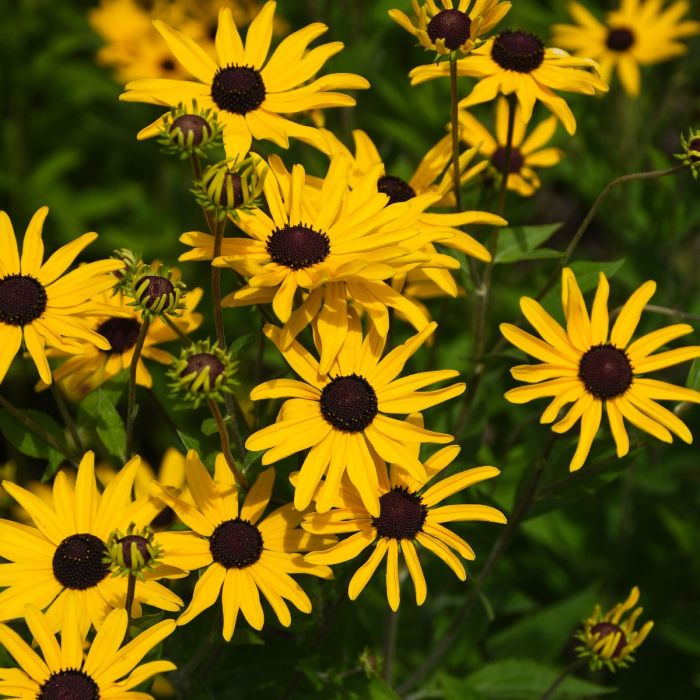Rudbeckia, Sweet Black Eyed Susan 'Minnesota Native'




Out of stock
Coming soon, still growing- Sun Preference
- Full-Sun
- Bloom Time
- August, September, October
Description
Luxuriant deep green foliage and butter-yellow blooms with shimmering redbrown centers. Medium to moist soils.
Minnesota's Largest Selection of Perennials
Discover an unparalleled selection of perennials at Gertens! With the largest variety in Minnesota, we offer endless options of colorful perennials, natives, and pollinator plants to beautify your garden year after year. From vibrant flowers to lush foliage, our perennials are perfect for adding beauty and charm to your outdoor space. Visit Gertens today and see why we're known as Minnesota's Destination Garden Center!
Details
Sweet Coneflower | Rudbeckia subtomentosa
Height: 4 feet
Spacing: 18 inches
Sunlight: full sun
Hardiness Zone: 4a
Other Names: Black Eyed Susan
Description:
This interesting variety features sunny, daisy-like flowers with dark brown button centers; has a mild anise scent; great for cut flowers; an upright, branched grower that makes it a great specimen in the back of borders; very appealing
Ornamental Features
Sweet Coneflower has masses of beautiful lightly-scented yellow daisy flowers with dark brown eyes at the ends of the stems from early summer to early fall, which are most effective when planted in groupings. The flowers are excellent for cutting. Its tomentose pointy leaves remain green in color throughout the season.
Landscape Attributes
Sweet Coneflower is an herbaceous perennial with an upright spreading habit of growth. Its medium texture blends into the garden, but can always be balanced by a couple of finer or coarser plants for an effective composition.
This is a relatively low maintenance plant, and should be cut back in late fall in preparation for winter. It is a good choice for attracting butterflies to your yard, but is not particularly attractive to deer who tend to leave it alone in favor of tastier treats. It has no significant negative characteristics.
Sweet Coneflower is recommended for the following landscape applications;
- Mass Planting
- General Garden Use
- Container Planting
Planting & Growing
Sweet Coneflower will grow to be about 4 feet tall at maturity, with a spread of 24 inches. When grown in masses or used as a bedding plant, individual plants should be spaced approximately 18 inches apart. It grows at a fast rate, and under ideal conditions can be expected to live for approximately 3 years. As an herbaceous perennial, this plant will usually die back to the crown each winter, and will regrow from the base each spring. Be careful not to disturb the crown in late winter when it may not be readily seen!
This plant should only be grown in full sunlight. It is very adaptable to both dry and moist locations, and should do just fine under typical garden conditions. It is considered to be drought-tolerant, and thus makes an ideal choice for a low-water garden or xeriscape application. It is not particular as to soil type or pH. It is highly tolerant of urban pollution and will even thrive in inner city environments. Consider applying a thick mulch around the root zone in winter to protect it in exposed locations or colder microclimates. This species is native to parts of North America. It can be propagated by division.
Sweet Coneflower is a fine choice for the garden, but it is also a good selection for planting in outdoor pots and containers. With its upright habit of growth, it is best suited for use as a 'thriller' in the 'spiller-thriller-filler' container combination; plant it near the center of the pot, surrounded by smaller plants and those that spill over the edges. It is even sizeable enough that it can be grown alone in a suitable container. Note that when growing plants in outdoor containers and baskets, they may require more frequent waterings than they would in the yard or garden. Be aware that in our climate, most plants cannot be expected to survive the winter if left in containers outdoors, and this plant is no exception. Contact our experts for more information on how to protect it over the winter months.
More Information
| Common Family Name | Black Eyed Susan |
|---|---|
| Gerten Grown Plants | Gerten Grown Plants |
| MN Native Plants | MN Native Plants |
| Sun Preference | Full-Sun |
| Bloom Time | August, September, October |
| Mature Spread (Range) | 12" - 24" |
| Mature Height (Range) | 25" - 36" |
| USDA Hardiness Zone | 4, 5, 6, 7, 8 |


